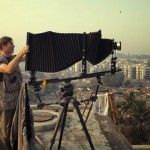 Explore the works of Robert Polidori, who uses a large-format camera to capture environments that range from the French palace of Versailles to the destruction caused by Hurricane Katrina or the nuclear accident at Chernobyl. Polidori has been criticized for the absence of people in his photographs. Do you think his photographs aestheticize the settings of catastrophe? Or do you think they are powerful statements of unique events?
Explore the works of Robert Polidori, who uses a large-format camera to capture environments that range from the French palace of Versailles to the destruction caused by Hurricane Katrina or the nuclear accident at Chernobyl. Polidori has been criticized for the absence of people in his photographs. Do you think his photographs aestheticize the settings of catastrophe? Or do you think they are powerful statements of unique events?
Read a recent interview with Robert Polidori here
Explore Polidori’s photographs at Edwynn Houk Gallery’s website
Please post your responses by Friday, October 21. Please note: due to the upcoming midterm on October 20, you have TWO weeks to post/comment on this discussion topic
See instructions on how to “post” and “comment” under “Blogging Guidelines” above.




Polidori seems to believe that all catastrophe’s that happens are just a simple part of nature, and nature is a beautiful thing.I would say that polidori is drawn to the more darker side of life, he captures the unusual. Its as if he loves the idea of a catastrophe and the idea that its a normal thing. Most things that he have captured shows the other side of life. Many people when we see a photography its made to be perfect, seeming that everything in life is perfect. Polirodi on the other hand captures the “ugly” in life. When he states that “he prefers the qualities of beauty”, and his quality of beauty is what nature and life does to society.I think its photographs are more powerful statements of unique events, rather than anything else.
I believe Polidori’s main focus in his photographs are people. Now this may sound strange after reading this: “Polidori has been criticized for the absence of people in his photographs”, but let me explain. He states that homes are exoskeletons of people’s internal lives. When he photographs a room, he envisions a history of whoever lived there. I imagine him becoming fascinated by the items in the room; why is this thing placed where it is? how did it come in this person’s possession? why is this thing not present? All these questions make him that much more intrigued and he finds beauty in this.
The same goes for his photos of cities. Polidori is captivated by the way this particular city is individualized by the people who live there and how/why they influence it. Looking at his “chaos work”, I feel that he wants his audience to sympathize with the losses that these people suffered. If rooms symbolize a person’s internal life, then you should understand what it means to see it in rubble.
Polidori has an interesting outlook on photography. It seems he likes to capture the realness of a specific area, like when he took pictures after Hurricane Katrina. He also likes to capture things that have a humanness to them, like when he says that peoples homes are exoskeletons of people’s internal lives. which is true in a way because some people who have messy houses have a lot going on in their lives and their house is a reflection of it.
I think Polidori’s work focuses more on the powerful statements of unique events. His photography tells us and informs us about the chaos in the world. He goes in depth by photographing houses that have been destroyed by natural disasters. He captures the uncommon and brings us into the “rare” notion of the events that we might want to forget. This evokes feelings of sympathy, sadness, and/or frustration. Polidori sees chaos as beauty. As quoted from the excerpt, “Chaos is interesting. That’s where the world comes from.”-Robert Polidori states. He feels drawn to photograph the destruction of the world. Perhaps photographing the destruction of the world makes him feel like there can be hope and that people can become stronger. Or maybe he believes that if people are able to see the chaos through his photographs that perhaps somehow they will get the message and tried to change their ways.
Robert Polidori kicks ass! The quality of images is absolutely amazing. You get what you put into it. He travels around with the biggest camera I have ever seen into very tough and uncomfortable surroundings such as New Orleans after Katrina and the results were amazing. Thankfully he documents these catastrophes. His work will most likely be educational tools for the next generation. I love his attitude and versatility. He seems to go after what he wants and doesn’t care what people think which is why I find interesting that he can work on fashion campaigns where he relinquishes some of his creative control. But that doesn’t make him a sell out because his work looks great on a commercial level as well. Its like Jay-Z’s reasonable doubt versus The Black album. They are both different but great. To me, it shows diversity in his style. I will add him to my list of favorite photographers.